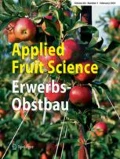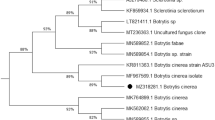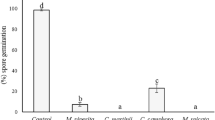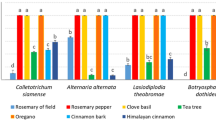Abstract
In recent years, the use of natural components such as essential oils has been introduced as a new way to control fungal infections. In this study, the effect of the essential oils of anise, chamomile, marjoram, black caraway, and thyme on inhibiting the growth of Alternaria alternata fungi in barberry under in vitro and in vivo conditions was tested, using a completely randomized design involving five concentrations (0, 200, 400, 600, and 800 μL L−1) with three repetitions. In vitro results showed that by increasing the concentration of all essential oils, their antifungal activity increased. The best inhibitory effect on A. alternata fungi was related to the use of thyme essential oil, followed by black caraway, marjoram, chamomile, and anise, respectively, such that the growth of the fungus was stopped at a concentration of 400 μL L−1 for thyme essential oil. In in vivo conditions, the lowest percentage of fruit weight loss was observed with thyme treatment at 600 μL L−1 and a 0.02% concentration. The content of total soluble solids was highest with black caraway treatment (200 μL L−1) and was lowest with the control treatment. The highest acidity was obtained in barberry treated with thyme oil at 400 μL L−1, with a pH of 2.10. The highest antioxidant content was observed with chamomile essential oil at 200 μL L−1 (80.4 mg L−1), and the lowest was seen with anise essential oil at 600 μL L−1 (21.0 mg L−1). The highest phenol content was obtained with marjoram oil at 400 μL L−1 (83.18 mg L−1). Treatment with anise (151.10 mg L−1) and marjoram (22.91 mg L−1) essential oils yielded the highest and the lowest anthocyanin content, respectively. Overall, the best results were found with treatment with thyme and black caraway oils (800 μL L−1). The use of essential oils of medicinal plants to prevent the growth of A. alternata fungus in laboratory conditions and the effect of these oils on controlling contamination in barberry fruit are new aspects of this project. Recent studies have shown that plant essential oils can be used to control plant diseases in agriculture.
Similar content being viewed by others
References
Abdolmaleki M, Bahraminejad S, Salari M, Abbasi S, Panjeke N (2011) Antifungal activity of peppermint (Mentha piperita L.) on phytopathogenic fungi. J Med Plants 10(38):26–34
Alikhani M, Sharifani M, Azizi M, Hemati K, Mousavizadeh S (2009) The effect of some natural compounds in shelf-life and quality of pear fruit (Esfahan Shah Mive cultivar). J Agric Sci Nat Resour 16(3):158–171
Aminifard MH, Bayat H (2018) Antifungal activity of black caraway and anise essential oils against Penicillium digitatum on blood orange fruits. Int J Fruit Sci 18(3):307–319
Aminifard MH, Mohammadi S (2013a) Efficacy of plant essential oils to control post-harvest decay of sweet cherry (Prunus avium L.) fruit. J Hortic Sci Biotechnol 88(1):79–84
Aminifard MH, Mohammadi S (2013b) Essential oils to control Botrytis cinerea in vitro and in vivo on plum fruits. J Sci Food Agric 93(2):348–353
Anaissie E, Bodey G, Rinaldi M (1989) Emerging fungal pathogens. Eur J Clin Microbiol Infect Dis 8(4):323–330
Asgari Marjanlu A, Mostofi Y, Shoeibi S, Maghoumi M (2009) Effect of basil (Ocimum basilicum L.) essential oil on gray mold control and postharvest quality of strawberry (cv. Selva). J Med Plants 4(29):131–139 (In Persian)
Axinte L, Cuzman A, Feci E, Palanti S, Tiano P (2011) Cinnamaldehyde, a potential active agent for the conservation of wood and stone religious artefacts. Eur J Sci Theol 7(1):25–34
Baka ZA, Rashad YM (2016) Alternative control of early blight of tomato using plant extracts from Acacia nilotica, Achillea fragrantissima and Calotropis procera. Phytopathol Mediterr 55(1):121–129
Bakkali F, Averbeck S, Averbeck D, Idaomar M (2008) Biological effects of essential oils—a review. Food Chem Toxicol 46(2):446–475
Begum MF, Mahal MF, Alam MS (2010) Inhibition of spore germination and mycelial growth of three fruit rot pathogens using some chemical fungicides and botanical extracts. J Life Earth Sci 5:23–27
Blois MS (1958) Antioxidant determinations by the use of a stable free radical. Nature 181(4617):1199–1200
Bruni R, Medici A, Andreotti E, Fantin C, Muzzoli M, Dehesa M et al (2004) Chemical composition and biological activities of Ishpingo essential oil, a traditional Ecuadorian spice from Ocotea quixos (Lam.) Kosterm. (Lauraceae) flower calices. Food Chem 85(3):415–421
Calo JR, Crandall PG, O’Bryan CA, Ricke SC (2015) Essential oils as antimicrobials in food systems—A review. Food Control 54:111–119
Chethana B, Ganeshan G, Rao AS, Bellishree K (2012) In vitro evaluation of plant extracts, bioagents and fungicides against Alternaria porri (Ellis) Cif., causing purple blotch disease of onion. Pest Management in Horticultural. Ecosystems 18(2):194–198
Combrinck S, Regnier T, Kamatou G (2011) In vitro activity of eighteen essential oils and some major components against common postharvest fungal pathogens of fruit. Ind Crop Prod 33(2):344–349
Dellavalle PD, Cabrera A, Alem D, Larrañaga P, Ferreira F, Rizza MD (2011) Antifungal activity of medicinal plant extracts against phytopathogenic fungus Alternaria spp. Chil J Agric Res 71(2):231–239
El-Mohamedy RSR (2017) Plant essential oils for controlling plant pathogenic fungi. In: Volatiles and food security. Springer, Singapore, pp 171–198
Emmons CL, Peterson DM, Paul GL (1999) Antioxidant capacity of oat (Avena sativa L.) extracts. 2. In vitro antioxidant activity and contents of phenolic and tocol antioxidants. J Agric Food Chem 47(12):4894–4898
Fatemi H, Aminifard MH, Mohammadi S (2013) Efficacy of plant essential oils on post-harvest control of rot caused by Botrytis cinerea on kiwi fruits. Arch Phytopathol Plant Prot 46(5):536–547
Ferhout H, Bohatier J, Guillot J, Chalchat J (1999) Antifungal activity of selected essential oils, cinnamaldehyde and carvacrol against Malassezia furfur and Candida albicans. J Essent Oil Res 11(1):119–129
Ganie S, Ghani M, Nissar Q, Rehman S (2013) Bioefficacy of plant extracts and biocontrol agents against Alternaria solani. Afr J Microbiol Res 7(34):4397–4402
Hadizadeh I, Pivastegan B, Hamzehzarghani H (2009) Antifungal activity of essential oils from some medicinal plants of Iran against Alternaria alternata. Am J Appl Sci 6(5):857–861
Hosseini A, Moradinezhad F (2018) Effect of short-term high CO2 treatment on quality and shelf life of button mushroom (Agaricus bisporus) at refrigerated storage. Journal of Horticulture Postharvest Research 1(1-March 2018):37–48
Jahani M, Pira M, Aminifard MH (2020) Antifungal effects of essential oils against Aspergillus niger in vitro and in vivo on pomegranate (Punica granatum) fruits. Sci Hortic 264:109188
Kafi M, Balandri A, Rashed Mohasel M, Karbasi A, Marashi H, Maskouki A (2002) Barberry: production and process technology. Language and Literature Institute, , pp 45–60 (In Persian)
Kantwa S, Tetarwal J, Shekhawat K (2014) In vitro effect of fungicides and phyto-extracts against Alternaria alternata causing leaf blight of groundnut. IOSR J Agric Vet Sci 7(6):28–31
Kashkooli RI, Najafi SS, Sharif F, Hamedi A, Asl MKH, Kalyani MN et al (2015) The effect of Berberis vulgaris extract on transaminase activities in non-alcoholic fatty liver disease. Hepat Mon 15(2):e25067
Keshavarz A, Taheri P, Tariqi S (2014) Evaluation of inhibition effect of medicinal essential oils on Alternaria spp. colony growth in vitro. In: The Second National Conference of Medicinal Herbs and Organic Agriculture (Paper)
Lahooji A, Mirabolfathy M, Karami-Osboo R (2010) Effect of Zataria multiflora and Satureja hortensis essential oils, thymol and carvacrol on growth of Fusarium gramineum isolates and deoxynivalenol production. Iranian. J Plant Pathol 46(1):37–50
Lee HB et al (2015) Alternaria in food: ecophysiology, mycotoxin production and toxicology. Mycobiology 43(2):93–106
Mohammadi S, Aminifard MH (2013) Inhibition of grey mould in vitro and in vivo with essential oil of fennel (Foeniculum vulgare L.). J Cent Eur Agric 14(1):420–431
Moradinezhad F, Mehregan M, Jahani M (2018) Physicochemical traits of seedless barberry (Berberis vulgaris L.) fruits stored under refrigeration as affected by heat and calcium chloride treatments. Cercet Agron Mold 51(4):73–86
Moreira M, Ponce A, Del Valle C, Roura S (2005) Inhibitory parameters of essential oils to reduce a foodborne pathogen. LWT Food Sci Technol 38(5):565–570
Moretti A, Logrieco AF, Susca A (2017) Mycotoxins: an underhand food problem. In: Mycotoxigenic fungi. Springer, New York, pp 3–12
Özden Ç, Bayindirli L (2002) Effects of combinational use of controlled atmosphere, cold storage and edible coating applications on shelf life and quality attributes of green peppers. Eur Food Res Technol 214(4):320–326
Pandey AK, Kumar P, Singh P, Tripathi NN, Bajpai VK (2017) Essential oils: sources of antimicrobials and food preservatives. Front Microbiol 7:2161
Raja P (2010) Fungitoxic properties of plant extracts against Alternaria tenuissima: new sp. infecting eggplant in India. Indian Phytopathol 63(1):45–46
Rama Devi P, Tanuja Pryia B, Sunitha P, Rajasekhar M (2015) Bioefficacy of plant extracts against Alternaria alternata, leaf blight pathogen of Senna (Cassia angustifolia). Int J Multidiscip Res 2(1):7–11
Ranjbari F, Moradinezhad F, Khayyat M (2016) Effect of nitric oxide on biochemical and antioxidant properties of pomegranate fruit cv. Shishe-kab during cold. Int J Hortic Sci Technol 3(2):211–219
Rapisarda P, Fanella F, Maccarone E (2000) Reliability of analytical methods for determining anthocyanins in blood orange juices. Journal of Agricultural Food Chemistry 48(6):2249–2252
Rattanapitigorn P, Arakawa M, Tsuro M (2006) Vanillin enhances the antifungal effect of plant essential oils against Botrytis cinerea. Int J Aromather 16(3/4):193–198
Raut JS, Karuppayil SM (2014) A status review on the medicinal properties of essential oils. Ind Crop Prod 62:250–264
Rios J, Recio M (2005) Medicinal plants and antimicrobial activity. J Ethnopharmacol 100(1/2):80–84
Serrano M, Martinez-Romero D, Castillo S, Guillen F, Valero D (2005) The use of the natural antifungal compounds improves the beneficial effect of MAP in sweet cherry storage. Innovat Food Sci Emerg Technol 6(1):115–121
Swami C, Alane S (2013) Efficacy of some botanicals against seed-borne fungi of green gram (Phaseolus aureus Roxb.). Biosci Discov 4(1):107–110
Vesaltalab Z, Gholami M (2012) The effect of clove buds and rosemary extracts and essences on control of Botrytis cinerea growth. Plant Prod Technol 11(2):1–11
Waghmare M (2014) Ecofriendly approaches for the management of Alternaria zinniae Pape. causing flower blight of Tagetes erecta L. Curr Biotechnol 8(3):317–321
Wang K, Jiang S, Pu T, Fan L, Su F, Ye M (2019) Antifungal activity of phenolic monoterpenes and structure-related compounds against plant pathogenic fungi. Nat Prod Res 33(10):1423–1430
Yazgi M, Awad D, Jreikous B (2015) Screening of the antifungal activity of plant Mentha longifolia crude extracts against two fungi Alternaria citri and Fusarium moniliforme. J Entomol Zool Stud 3(2):359–364
Author information
Authors and Affiliations
Corresponding author
Ethics declarations
Conflict of interest
E. Sazvar, M. Jahani, M.H. Aminifard, and S.A. Hosseini declare that they have no competing interests.
Rights and permissions
About this article
Cite this article
Sazvar, E., Jahani, M., Aminifard, M.H. et al. In Vitro and In Vivo Control of Alternaria alternata in Barberry (Berberis vulgaris) by Some Essential Oils. Erwerbs-Obstbau 64, 413–423 (2022). https://doi.org/10.1007/s10341-022-00645-2
Received:
Accepted:
Published:
Issue Date:
DOI: https://doi.org/10.1007/s10341-022-00645-2




